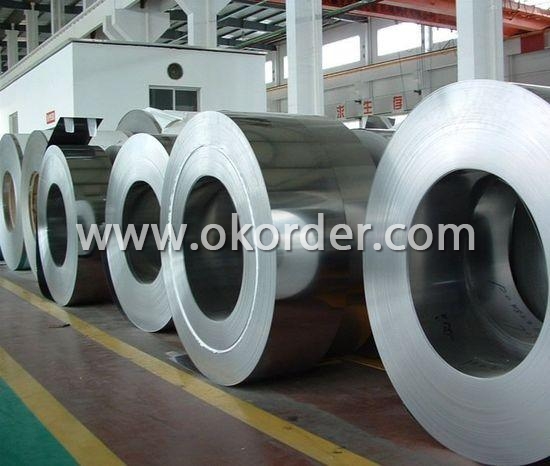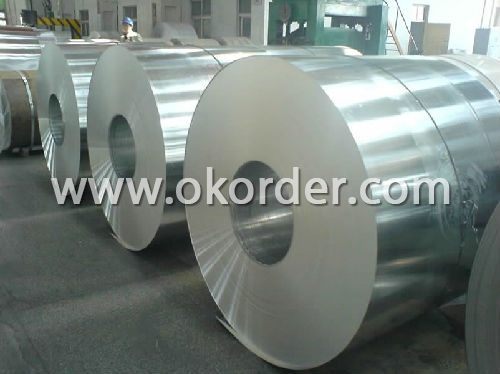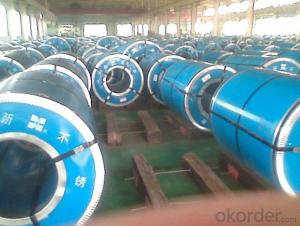316L Stainless Steel Coil
- Loading Port:
- China Main Port
- Payment Terms:
- TT or LC
- Min Order Qty:
- 1 Ton m.t.
- Supply Capability:
- 1000 Tons Per Month m.t./month
OKorder Service Pledge
OKorder Financial Service
You Might Also Like
316L Stainless Steel Coil
1. Chemical composition of 316L Stainless Steel Coil
C | Si | Mn | P | S | Ni | Cr |
Max0.03 | max1.00 | max2.00 | max0.045 | max0.03 | 10.00-14.00 | 16.00-18.00 |
2. Mechanical properties of 316L Stainless Steel Coil
Yield Strength | Tensile | Elongation | Hardness (HV) | Hardness (HRB) |
≥175 | ≥480 | ≥40 | ≤200 | ≤90 |
3. Standard of 316L Stainless Steel Coil : AISI, ASTM, GB, EN, DIN, JIS
4. Surface of 316L Stainless Steel Coil : 2B, NO.1, BA, NO.4, Hairline, SB, Mirror finish, Anti-skid, Cherkered etc.
5. Size of 316L Stainless Steel Coil :
Thickness: 0.3-3mm (cold rolled), 3-40mm (hot rolled)
Width: 1000mm or 1219mm or 1240mm for cold rolled, 1500mm for hot rolled.
Length: As customers' request.
6. MOQ of 316L Stainless Steel Coil : 1 Ton
7. Payment terms of 316L Stainless Steel Coil : T/T or L/C
8. Packing of 316L Stainless Steel Coil : Seaworthy package with wooden or Iron pallets with the paper and the steel strip,
or as customers' request.
9. Delivery time of 316L Stainless Steel Coil : Usually about 7 days after we confirming the order, or according to your quantity.
If you have any question or demand, pls feel free to contact me.


- Q:Can stainless steel strips be hardened?
- Yes, stainless steel strips can be hardened through a process called cold working or by heat treatment methods such as quenching and tempering.
- Q:Are 111 stainless steel strips suitable for chemical pipelines?
- Stainless steel strips with the grade 111 are not suitable for chemical pipelines. Grade 111 stainless steel does not exist in the standard stainless steel grading systems such as AISI or ASTM. It is important to use stainless steel grades that are specifically designed for chemical pipelines, such as 304 or 316L. These grades offer excellent resistance to corrosion and are widely used in various chemical and petrochemical industries. Using stainless steel strips with an unknown or non-standard grade can result in corrosion, leaks, and failure of the pipeline system, which could pose significant risks and safety hazards.
- Q:Are stainless steel strips suitable for HVAC applications?
- Yes, stainless steel strips are suitable for HVAC (heating, ventilation, and air conditioning) applications. Stainless steel is a highly versatile and durable material that offers excellent resistance to corrosion, heat, and pressure. These characteristics make it ideal for use in HVAC systems, which often operate in demanding environments. Stainless steel strips are commonly used in HVAC applications for various purposes. They are frequently used for manufacturing air ducts, which are essential components in HVAC systems for distributing heated or cooled air throughout a building. Stainless steel strips provide the necessary strength, rigidity, and resistance to withstand the pressure and temperature fluctuations that occur in ductwork. Additionally, stainless steel strips are also used in HVAC systems for producing heat exchangers, which are crucial for transferring thermal energy between fluids. The corrosion resistance of stainless steel ensures that the heat exchangers can withstand the exposure to different liquids and gases without deteriorating over time. Furthermore, stainless steel strips are preferred in HVAC applications due to their hygienic properties. They are easy to clean, maintain, and do not support the growth of bacteria or mold, making them ideal for use in environments where air quality is critical, such as hospitals and laboratories. In conclusion, stainless steel strips are well-suited for HVAC applications. Their excellent corrosion resistance, durability, and hygienic properties make them a reliable choice for manufacturing air ducts, heat exchangers, and other components used in HVAC systems.
- Q:How is corrosion resistance achieved in stainless steel strips?
- Corrosion resistance in stainless steel strips is achieved through a combination of factors inherent to the composition and structure of stainless steel. The primary element responsible for corrosion resistance in stainless steel is chromium. When chromium is added to the steel alloy in significant amounts (usually at least 10.5%), it forms a thin, passive oxide layer on the surface of the steel. This oxide layer, also known as a passive film, acts as a barrier, preventing further corrosion and protecting the underlying steel from exposure to corrosive elements. In addition to chromium, stainless steel also contains other alloying elements such as nickel, molybdenum, and nitrogen, which further enhance its corrosion resistance. These elements help to stabilize the passive film and improve the steel's resistance to specific types of corrosion, including pitting corrosion, crevice corrosion, and stress corrosion cracking. The microstructure of stainless steel also plays a crucial role in its corrosion resistance. Stainless steel can exist in different crystal structures, such as austenitic, ferritic, martensitic, and duplex. The most common type used in stainless steel strips is austenitic stainless steel, which has a face-centered cubic (FCC) structure. This structure provides excellent corrosion resistance and makes stainless steel strips suitable for a wide range of applications. Furthermore, stainless steel strips can undergo various surface treatments to enhance their corrosion resistance. These treatments include passivation, pickling, and electropolishing, which help to remove impurities, contaminants, and free iron from the surface, promoting the formation of a more robust and protective oxide layer. Overall, the combination of the alloying elements, passive film formation, microstructure, and surface treatments contribute to the exceptional corrosion resistance of stainless steel strips, making them highly durable and suitable for various environments and applications where corrosion is a concern.
- Q:What is the maximum thickness available for stainless steel strips?
- The maximum thickness of stainless steel strips can differ based on the particular grade of stainless steel and the manufacturing capabilities of the supplier. Nevertheless, stainless steel strips can generally be manufactured in thicknesses ranging from 0.1 millimeters to multiple millimeters. Certain suppliers may have the ability to offer even thicker strips upon request, but it is crucial to communicate with the supplier to ascertain the maximum thickness available for the specific grade and project requirements.
- Q:What is stainless steel strip?
- Stainless steel strip, a slender and flat piece of stainless steel material, is widely utilized in diverse industries for a multitude of purposes. It is composed of a corrosion-resistant alloy of iron and chromium, with the potential inclusion of elements like nickel or molybdenum. Its smooth and polished surface is attained through hot rolling, cold rolling, or annealing processes. Possessing exceptional strength, durability, and corrosion resistance, stainless steel strip is highly favored in numerous sectors. It is commonly employed in the production of components for kitchen appliances, automotive parts, construction materials, electronic devices, medical equipment, and various other products. Depending on the specific requirements of the application, stainless steel strip can be further processed to obtain different shapes, sizes, or thicknesses, showcasing its versatility. Furthermore, stainless steel strip is available in diverse grades and finishes, each exhibiting distinct properties and characteristics. Austenitic, ferritic, and martensitic grades are classifications within the stainless steel strip category, offering unique attributes such as high temperature resistance, magnetic properties, or enhanced strength. The selection of grade and finish is contingent upon the intended use and the environmental conditions to which the strip will be subjected. To sum up, stainless steel strip is an adaptable and resilient material that serves a myriad of purposes across various industries. Its corrosion resistance, strength, and malleability make it a dependable option for manufacturers in search of high-quality and long-lasting products.
- Q:What is the typical thickness range for stainless steel strips?
- The typical thickness range for stainless steel strips can vary, but it is generally between 0.015 inches (0.38 mm) to 0.1875 inches (4.76 mm).
- Q:What is the maximum temperature that stainless steel strips can withstand?
- The maximum temperature that stainless steel strips can withstand depends on the specific grade of stainless steel. However, most stainless steel alloys can withstand temperatures up to 1500 degrees Fahrenheit (815 degrees Celsius) before significant structural changes occur.
- Q:Can stainless steel strips be polished to a mirror-like finish?
- Yes, stainless steel strips can be polished to achieve a mirror-like finish. This process involves using progressively finer abrasive materials to remove imperfections and create a smooth, reflective surface.
- Q:Can stainless steel strips be used for architectural canopies?
- Yes, stainless steel strips can be used for architectural canopies. Stainless steel is known for its durability, strength, and resistance to corrosion, making it a popular choice for architectural applications. The strips can be shaped and fabricated to create unique and visually appealing canopies that offer protection from the elements while maintaining a sleek and modern aesthetic.
1. Manufacturer Overview |
|
|---|---|
| Location | Zhejiang,China |
| Year Established | 2010 |
| Annual Output Value | Above US$16Million |
| Main Markets | Japan, South America |
| Company Certifications | ISO9001:2000; |
2. Manufacturer Certificates |
|
|---|---|
| a) Certification Name | |
| Range | |
| Reference | |
| Validity Period | |
3. Manufacturer Capability |
|
|---|---|
| a)Trade Capacity | |
| Nearest Port | Shanghai |
| Export Percentage | 60% |
| No.of Employees in Trade Department | 50 People |
| Language Spoken: | English;Chinese; Japanese |
| b)Factory Information | |
| Factory Size: | Above 80,000 square meters |
| No. of Production Lines | Above 8 |
| Contract Manufacturing | OEM Service Offered;Design Service Offered |
| Product Price Range | Average |
Send your message to us
316L Stainless Steel Coil
- Loading Port:
- China Main Port
- Payment Terms:
- TT or LC
- Min Order Qty:
- 1 Ton m.t.
- Supply Capability:
- 1000 Tons Per Month m.t./month
OKorder Service Pledge
OKorder Financial Service
Similar products
New products
Hot products
Hot Searches
Related keywords





























